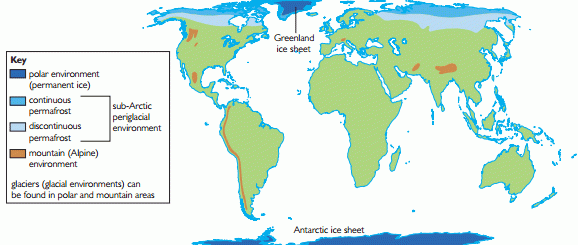Global Distribution
In this section you will learn about:
- the distribution of ice in the UK 18000 years ago
- the different types of cold environment
- the present-day distribution of cold environments
Cold Environments in the past
About 18000 years ago, much of the Northern Hemisphere was plunged into an ice age. In the UK, only southern Britain escaped being covered by ice. Scientists believe that this was one of as many as 20 glacial periods – each one separated by a warmerinter-glacial. Collectively, this period of time – lasting from 2 million years ago until about 8000 years ago – is known as the Ice Age. Some people think that we may still be in the ‘Ice Age’, and that the current warm period of a few thousand years is just another inter-glacial!
The weathering and erosion processes that operated during the glacial periods were responsible for creating many of today’s landscape features, including spectacular glacial valleys, jagged pyramidal peaks, and deep ribbon lakes.

Global Distribution of Cold Environments
Cold environments experience significant periods of time when the temperature is close to or below 0°C. In the most extreme cold environments, such as parts of Antarctica, the temperature can stay well below 0°C throughout the year – sometimes plummeting to as low as –60°C. Other, less-extreme, cold environments simply experience cold winters, such as the Alps in Europe or the Rockies in Canada.
There are four main types of cold environment: polar, alpine, glacial, and periglacial.

Polar Environments
In winter, temperatures often drop to –50°C! They include Antarctica, Greenland and some of the islands inside the Arctic and Antarctic Circles, such as Spitzbergen. Despite the snowy image of these polar environments, they are very dry – with relatively low amounts of precipitation (snow). There are also extensive areas of sea ice, particularly in the Arctic.
Alpine Environments
Moutain area such as the Alps, experience very cold winters with heavy snow. Because of the high altitude, the temperature can drop to –10°C or less. The extreme winter cold is replaced in the summer with warmer weather, where the temperature can even exceed 20°C.
Periglacial Environments
Periglacial literally means ‘edge’ of glacial. Periglacial environments are found on the fringes of polar or glacial environments, e.g. in parts of Siberia, Canada and Greenland. Periglacial areas experience permanently frozen ground (permafrost). During their brief warmer summers, the ground surface layer thaws – enabling hardy plants to grow. Periglacial environments are not permanently covered by ice.
Glacial Environments
These environments are specifically associated with glaciers. While some enormous glaciers are found in polar environments, most of the world’s actively moving glaciers are found high up in alpine mountain regions. The heavy winter snowfall in those areas provides the ice to feed the glaciers. Then, in the summer, meltwater lubricates the glaciers – helping them to move like giant conveyor belts down the alpine valleys.
Distribution of Polar Landscapes
About 20 million km2 of treeless tundra is found on Earth in the two polar zones and in alpine regions.
- Polar climates occur poleward of the 10° C isotherm for the warmest month, and the summer position of the arctic/antarctic Front separating Arctic/Antarctic air masses from polar air masses.
- Some ecologists prefer to use the Nordenskjöld line, an isopleth of the mean temperature of the warmest month equalling (9 – 0.1K), K being the mean temperature of the coldest month in degrees celsius.
- Although the 10° C January temperature works quite well in the Antarctic, many prefer the marine Antarctic Convergence which separates cold antarctic water from cool subantarctic water.
- The details of climates in polar regions are much affected by the incursion of ocean currents from warmer latitudes.
